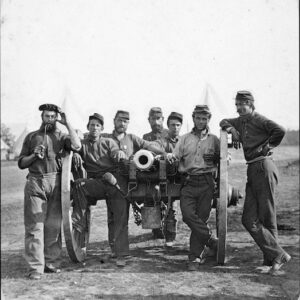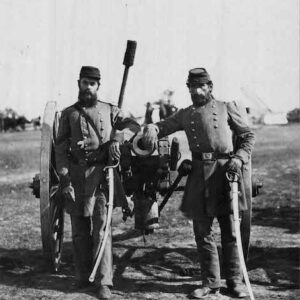Tag: M1841 6-pounder field gun
 Wikipedia says: The M1841 6-pounder field gun was a bronze smoothbore muzzle-loading cannon that was adopted by the United States Army in 1841 and used from the Mexican–American War to the American Civil War. It fired a 6.1 lb (2.8 kg) round shot up to a distance of 1,523 yd (1,393 m) at 5° elevation. It could also fire canister shot and spherical case shot. The cannon proved very effective when employed by light artillery units during the Mexican–American War. The cannon was used during the early years of the American Civil War, but it was soon outclassed by newer field guns such as the 12-pounder Napoleon. In the US Army, the 6-pounders were replaced as soon as more modern weapons became available and none were manufactured after 1862. However, the Confederate States Army continued to use the cannon for a longer period because the lesser industrial capacity of the South could not produce newer guns as fast as the North.
Wikipedia says: The M1841 6-pounder field gun was a bronze smoothbore muzzle-loading cannon that was adopted by the United States Army in 1841 and used from the Mexican–American War to the American Civil War. It fired a 6.1 lb (2.8 kg) round shot up to a distance of 1,523 yd (1,393 m) at 5° elevation. It could also fire canister shot and spherical case shot. The cannon proved very effective when employed by light artillery units during the Mexican–American War. The cannon was used during the early years of the American Civil War, but it was soon outclassed by newer field guns such as the 12-pounder Napoleon. In the US Army, the 6-pounders were replaced as soon as more modern weapons became available and none were manufactured after 1862. However, the Confederate States Army continued to use the cannon for a longer period because the lesser industrial capacity of the South could not produce newer guns as fast as the North.
From 1820 to 1840, American cannon founders made cast iron 6-pounders that were less reliable than guns used in the War of 1812. In 1824, the Fort Pitt Foundry delivered 74 cast iron 6-pounder guns of an order of 100. A second order of 100 cast iron 6-pounders was delivered in 1828–1830 and at least 10 were rejected. Finally, 113 cast iron 6-pounders were manufactured in 1836–1838 and 22 were rejected. No more orders were placed with the Fort Pitt Foundry. In 1833, the Columbia Foundry produced two cast iron 6-pounders of which one burst during proof. They delivered 43 cast iron 6-pounders in 1834–1836 but these were the last ones produced by the Columbia Foundry. In 1840, an exasperated Secretary of War Joel Roberts Poinsett wrote, “…if guns sometimes fail, it is not because the gun is of iron, but because the founder is not perfect in his art. At present, he makes a good gun by accident, whereas it is by accident only that he should make a bad one.” Soon afterward, the problem was finally discovered. During this period, American cannon founders switched from cold blast to hot blast cast iron for reasons of economy and convenience; this led to more brittle cast iron guns.
Meanwhile, the West Point Foundry produced four bronze 6-pounders in 1834, of which three were rejected on sight. In 1835, the US Army Ordnance Board meeting in Watervliet, New York decided to switch to bronze field guns. In July 1836, two established bronze foundries, Cyrus Alger & Company of Boston and N. P. Ames of Cabotville, Massachusetts were hired to manufacture bronze 6-pounder guns. Alger produced 26 and Ames produced 32 bronze Model 1835 6-pounder guns. The Model 1838 bronze 6-pounder was a lighter cannon designed for horse artillery units. Alger delivered 62 and Ames delivered 36 of the Model 1838 gun. Ames also manufactured 27 Model 1840 bronze 6-pounders, which were heavier than the Model 1838.
The Model 1841 bronze 6-pounder cannon proved to be the most successful. The gun was not officially discarded by the US Army until 1868 though none were produced after 1862. Ames manufactured at least 646 Model 1841 guns and Alger produced at least 337. Of the latter group, 10 were so-called Cadet guns which weighed only 570 lb (258.5 kg). There were no recorded losses during proofing, though some of the guns varied as much as 10 lb (4.5 kg) from the official weight. Four of the Cadet guns were produced for the Virginia Military Institute, two for the Arkansas Military Institute, and four for the Georgia Military Institute. The Eagle Foundry of Miles Greenwood of Cincinnati delivered 97 bronze 6-pounders of which 43 were rifled between August 1861 and December 1862. The Western Foundry of William D. Marshall & Company of St. Louis manufactured 33 bronze 6-pounders of which six were rifled between December 1861 and May 1862. Henry N. Hooper & Company of Boston produced eight bronze 6-pounders and Revere Copper Company of Boston delivered two similar guns in February 1862.
The Model 1841 bronze 6-pounder gun barrel was 60 in (152.4 cm) from the base ring to the muzzle and weighed 880 lb (399.2 kg). The diameter of the bore (caliber) was 3.67 in (9.32 cm) and the bore length was 57.5 in (146.1 cm). This means the bore was 15.67 calibers long. The cannon fired a 6.1 lb (2.8 kg) round shot of 3.58 in (9.1 cm) diameter. The spherical case shot weighed 5.7 lb (2.6 kg) and released 41 musket balls when it burst. The canister round weighed 7.32 lb (3.3 kg) and contained 27 iron balls.[15] At 5° elevation, the gun could hurl the round shot a distance of 1,523 yd (1,392.6 m) with the standard firing charge of 1.25 lb (0.6 kg). At 4° elevation, the gun could throw the spherical case shot a distance of 1,200 yd (1,097.3 m).[16] Canister shot was effective up to a distance of 350 yd (320 m).
A 6-pounder battery typically included four 6-pounder field guns and two M1841 12-pounder howitzers. Altogether, the battery required 14 6-horse teams and seven spare horses. The teams pulled the six artillery pieces and limbers, six caissons, one battery wagon, and one traveling forge. Each caisson weighed 3,800 lb (1,724 kg) and carried two ammunition chests, each with 50 rounds. Each of the two limbers also carried one, so that each gun was supplied with four ammunition chests. The carriage for the 6-pounder gun weighed 900 lb (408 kg). A 6-pounder cannon and its limber weighed 3,185 lb (1,445 kg) when fully loaded with one 50-round ammunition chest. The 1864 U.S. Field Artillery Instructions recommended that each ammunition chest contain 25 round shot, 20 spherical case shot, and five canister rounds. Nine men manned each cannon, the gunner who commanded the gun and eight artillerists who were numbered according to their function.
Civil War
The M1841 bronze 6-pounder cannon proved to be a highly effective weapon during the Mexican–American War. However, American Civil War combat experience soon showed that bronze smoothbore 6-pounder field guns were no longer effective weapons. When George B. McClellan became commander of the Union Army of the Potomac he ordered that all of the old Model 1841 vintage guns be replaced by 12-pounder Napoleons. The older guns were replaced in the eastern armies first and the older model guns persisted in the western armies for a longer period of time. Surviving records show a westward migration of US Army artillery pieces that had become obsolete. The 6-pounders were quickly replaced by 12-pounder Napoleons, 3-inch Ordnance rifles, 10-pounder Parrott rifles, and other field guns. On 30 June 1863, the Department of the Cumberland reported having 24 smoothbore 6-pounders out of a total of 220 field artillery pieces, while the Department of the Ohio had only eight out of 72. Rifling was added to bronze 6-pounders, but this experiment was not successful because bronze wears more easily than iron. The rifling eroded rapidly, rendering the guns inaccurate. See James rifle.
Variants of the M1841 bronze 6-pounder were also manufactured in the Confederacy though records are sketchy. Because the South lacked the North’s industrial capacity, the 6-pounders were employed by Confederate armies for a longer period. Robert E. Lee wanted the old Model 1841 bronze guns to be melted down and recast into 12-pounder Napoleons. Nevertheless, there were still numbers of the old pieces serving with Southern armies as late as the Battle of Chancellorsville. At the Battle of Antietam on 17 September 1862, there were at least 41 6-pounder guns still being employed in Confederate batteries, while the Union Army of the Potomac had no 6-pounders. For example, the 4th Company, Washington Artillery (Eshleman’s) was equipped with two 6-pounders and two 12-pounder howitzers.
During the Battle of Pea Ridge on 7–8 March 1862, both armies still employed significant numbers of smoothbore and rifled 6-pounder field guns. In the Union army, three units were armed with four 6-pounder smoothbores and two 12-pounder howitzers: the 2nd Ohio Battery, 1st Iowa Independent Battery Light Artillery, and 3rd Iowa Independent Battery Light Artillery. The 4th Ohio Battery had four rifled 6-pounders and two 12-pounder howitzers. The 1st Independent Battery Indiana Light Artillery had four rifled and two smoothbore 6-pounder field guns. Battery “A”, 2nd Illinois Light Artillery Regiment had two rifled and two smoothbore 6-pounder field guns and two 12-pounder howitzers. In the Confederate army, Clark’s, Jackson’s, and Gorham’s Missouri batteries and Hart’s Arkansas Battery each had four 6-pounder smoothbores. Mixed batteries with 6-pounder smoothbores included Provence’s Arkansas Battery (2), and Wade’s (2), Tull’s (2), Guibor’s (2), and MacDonald’s (1) Missouri batteries. Tull’s Battery also had two rifled 6-pounder guns. Kneisley’s and Kelly’s Missouri batteries had an unknown number of 6-pounders. Kneisley’s guns were old cast iron pieces.
Showing all 6 resultsSorted by latest





